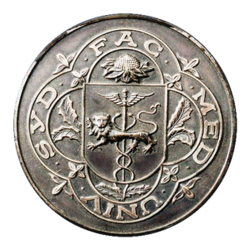Loading AI tools
From Wikipedia, the free encyclopedia
The University of Sydney School of Medicine, also known as Sydney Medical School (SMS) is the graduate medical school of the University of Sydney. Established in 1856, it is the first medical school in Australia.[1][2] In 2018, Sydney Medical School joined the newly formed Faculty of Medicine and Health at the University of Sydney. SMS is ranked 19th in the world and second in Australia in the 2021 QS Subject Rankings for medicine.[3]
 | |
| Type | Public |
|---|---|
| Established | 1856 |
Parent institution | University of Sydney |
| Head of School and Dean | Professor Stephen Fuller (Acting) |
| Location | , , 33°53′17″S 151°11′18″E |
| Campus | Urban |
| Website | sydney.edu.au/medicine |


The School has a large and diverse faculty[4] to support its missions in education, research, and health care. Each year, it has over 1,100 medical students and 2,000 postgraduate students undertaking coursework and research-training programs.[5]
Sydney Medical School was established in 1856 as The University of Sydney Faculty of Medicine by a group of University of Edinburgh Medical School graduates, Thomas Peter Anderson Stuart, Charles Nicholson and Alexander McCormick.
Sydney Medical School offers a four-year graduate medical program. Key course features include a hybrid problem-based learning model, early clinical exposure, online learning resources, and a focus on evidence-based medicine, which were modelled on aspects of the New Pathway Doctor of Medicine (MD) program at Harvard Medical School.[6] The curriculum has won numerous teaching awards and is licensed to universities in the UK, South Africa and the Middle East and to other universities in Australia.[7]
First introduced in 1997, the graduate medical program originally led to the degrees of Bachelor of Medicine and Bachelor of Surgery (MBBS) for historical reasons. Since 2014, the MD has replaced the MBBS as the title of the medical degree conferred by the Sydney Medical Program.[8]
Entry into the Sydney Medical Program is on the basis of an applicant's grade point average (GPA) and Graduate Medical School Admissions Test (GAMSAT) score. International applicants may submit a GAMSAT score or Medical College Admission Test (MCAT) score with their application. Applicants who achieve a satisfactory GPA (5.0, or 4.5 for rural applicants) are ranked for admissions offers on the basis of their GAMSAT or MCAT score.[9] Each year's cohort has approximately 300 students enrolled, an appreciable proportion of which are international students.[10]
The School also offers an undergraduate-entry, "combined medicine" pathway, in which a provisional place is held in the Sydney Medical Program for students until they complete one of the following three-year undergraduate degrees at the University:
Securing such a place is highly competitive, as only around forty such places are offered each year - thirty for domestic students and ten for international students. Entry is on the basis of the Australian Tertiary Admission Rank (ATAR) or equivalent, and a semi-structured panel interview.
Since the introduction of this admissions pathway in 2005,[11][12] the ATAR cut-off or equivalent has consistently been 99.95,[11][13][14][15][16] the highest cut-off of any undergraduate-entry program offered in Australia.[17][18]
The School has a very large research base, with its disciplines and affiliated institutes actively engaged in research in both the basic sciences and all major areas of clinical medicine, through six major themes:[19]
Sydney Health Ethics, previously the Centre for Values, Ethics and the Law in Medicine (VELiM), is an independent centre associated with the School of Public Health in the Sydney Medical School. It has also been associated with the Unit for the History and Philosophy of Science in the Faculty of Science .
The Centre was established in 1995.[20] It is a centre for academic research, for teaching and learning in bioethics and the medical humanities, and for ethical consultation and discussion.[21]
Sydney Medical School is supported by eight clinical schools, which are based at major teaching hospitals across New South Wales:[5]
A number of smaller hospitals also act as teaching hospitals.
Seamless Wikipedia browsing. On steroids.
Every time you click a link to Wikipedia, Wiktionary or Wikiquote in your browser's search results, it will show the modern Wikiwand interface.
Wikiwand extension is a five stars, simple, with minimum permission required to keep your browsing private, safe and transparent.